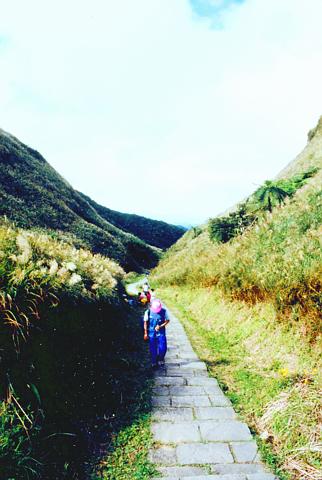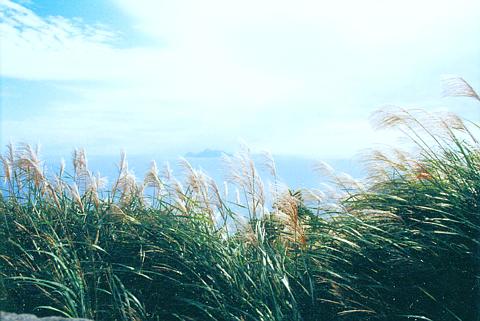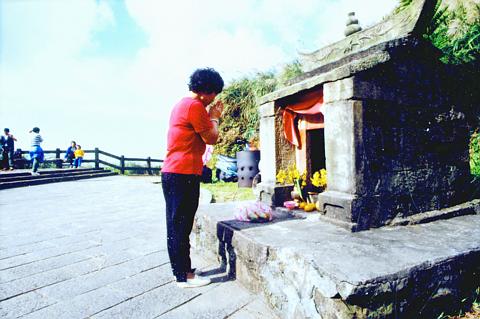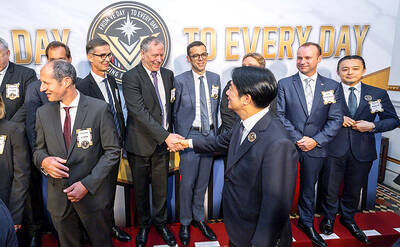A farmer, his face tan and riven with creases of age, bent over and hoed the soil while a cigarette dangled from his mouth.
He was preparing a hard-packed, stubborn plot of earth for ginger, some of which he would sell to the caravans of students and families that walked this section of the Tsaoling Historic Trail.
Noticing that we were watching him, a bit mystified as to what he was planting, he slowly straightened his bent frame, then quickly wandered over holding a stubby piece of ginger in fingers that looked as gnarled as the root itself.

PHOTO: MIKE CLENDENIN, TAIPEI TIMES
"Do you want to buy some," he asked with a gummy grin.
No, we said, but inquired as to what all the PVC tubing was for that lay scattered about.
He took a painfully long time to explain, grinning and gumming his cigarette the entire time, waving his arm across the field occasionally, before asking again good-naturedly if we wanted any ginger, or perhaps some other medicinal roots that he grew within the PVC.

PHOTO: MIKE CLENDENIN, TAIPEI TIMES
We politely declined again, so he shrugged and went back to his work as we fell back in with the procession of hikers strolling alongside the fallow fields that hem in the lower part of this 19th century migratory route.
Farming has probably been one of the few things that hasn't changed in this area since people started walking the Tsaoling trail more than 200 years ago, heading for the fertile Lanyang Plain of present-day Ilan County.
Tuti Kung (Earth God) temples still abound along the route that Aborigines first used as part of a larger network that wound from Tamshui to Ilan, but they are now joined by amenities that earlier travelers could only have wished for: interpretive plaques, bathroom facilities, pavilions and sausage and ice cream vendors.

PHOTO: MIKE CLENDENIN, TAIPEI TIMES
In contrast to the hikers who do walk it for fun, during the early 1800s, mainland immigrants used it to avoid a more hazardous journey around the northeast coast from Tamshui. It was developed by the then Taiwan prefect Yang Yan-li, who adopted the aboriginal trail to make settling the Lanyang easier.
Preserved section
Only a tiny portion of this trail remains today, but it is well developed and ideal as a one-day getaway from Taipei. Winding up through a sparsely populated valley north of Fulung beach, the trail passes by rice paddies, patches of wild lilies and old, sometimes abandoned homes as it runs toward a break in the coastal foothills.
Most people begin the hike on the north end, heading south toward Tali and the Jade Emperor Temple. During the four-hour trip, hikers pass through three distinctive ranges, beginning in a low-lying farming plain, then crossing below forested ridges that eventually lead to a windy promontory from which uninhabited Turtle Island may be seen just a few kilometers off the northeast coast.
On the way up, the most bucolic section of the trail comes about one hour into the journey, starting from when the trail breaks left before a bridge and ascends a stone staircase that parallels a brook. Moss-dappled walls, flagstones scuffed smooth by the shuffle of millions of feet and tiny hollows on the brook where the crawfish nibble at your feet are all characteristics of this section.
Climbing out of the valley and toward the neck of the pass, the scenery abruptly changes. Leafy canopies and tree-lined paths give way to hillsides swept with silvergrass, their long, pliant necks bent by the sea-chilled gusts that race through the pass, sucked inland by the valley's warmer climate.
About 50 meters before the top is a large stone tablet with the character "Hu" -- tiger -- carved into it Placed there in 1867 by Taiwan Regional Commander Liu Ming-teng, it was intended as protection against fierce winds that rake the hilltops.
Crowded summit
On a Sunday afternoon, hundreds of people will pass over the flagstone terrace at the top of the pass, and the pavilion there will be chockablock with people craning for views up the coast. Despite chilly weather, the remote earth god shrine here does a brisk business, with pious visitors lining up before it, hands in prayer and clamped around sticks of incense. Just above the nearby pavilion, at the end of a short feeder trail, lies a quieter perch that's ideal for picnicking.
Although the main part of trail continues, dropping quickly into Tali, a lot of people just return via the valley. If you do choose to push onward, it's about a half-hour's walk to the temple of the Jade Emperor.
There are a few country roads that lead off the main trail as you head back, offering the promise of further exploration. You may see the odd farmer toiling away or a cow here or there, but for the most part these offshoots seem like lonely places that only the locals go to. The crowds thin by around 4 or 5pm making this a more pleasant time to slip into a quiet nook along the stream and enjoy the final few hours away from city life.
For your information:
Transportation By train: Stop at the Kungliao station near Fulung and walk for about 40 minutes to the Yuanwang-keng trailhead. From Tali station, walk about 10 minutes to the Jade Emperor Temple trailhead.
By car: Take the Sun Yat-sen freeway to the Keelung or Patu exit, then take Route 2 south along the coast. There's plenty of signage pointing the way to the trailhead. FYI: Although it's possible to drive all the way to the trailhead, many people park their cars near a bridge that's only a kilometer or so off the coastal highway. Also, taking a car out to the trail on the weekend only takes less than an hour, but the trip back may take up to two depending on traffic.
By bus: The Taipei to Lotung Chunghsing bus leaves approximately every 20 minutes. Get off in Fulung or Tali. Fulung to Keelung buses leave about once an hour.
Miscellaneous: It can be quite warm at the bottom of the trail and cool at the top, so pack a light jumper, especially if you plan on hanging out for awhile at the top. It's possible to buy snacks and tea along the way on weekends when travelling from north to south, but bring along some water anyway to keep hydrated through the steep parts.

DEFENDING DEMOCRACY: Taiwan shares the same values as those that fought in WWII, and nations must unite to halt the expansion of a new authoritarian bloc, Lai said The government yesterday held a commemoration ceremony for Victory in Europe (V-E) Day, joining the rest of the world for the first time to mark the anniversary of the end of World War II in Europe. Taiwan honoring V-E Day signifies “our growing connections with the international community,” President William Lai (賴清德) said at a reception in Taipei on the 80th anniversary of V-E Day. One of the major lessons of World War II is that “authoritarianism and aggression lead only to slaughter, tragedy and greater inequality,” Lai said. Even more importantly, the war also taught people that “those who cherish peace cannot

Taiwanese Olympic badminton men’s doubles gold medalist Wang Chi-lin (王齊麟) and his new partner, Chiu Hsiang-chieh (邱相榤), clinched the men’s doubles title at the Yonex Taipei Open yesterday, becoming the second Taiwanese team to win a title in the tournament. Ranked 19th in the world, the Taiwanese duo defeated Kang Min-hyuk and Ki Dong-ju of South Korea 21-18, 21-15 in a pulsating 43-minute final to clinch their first doubles title after teaming up last year. Wang, the men’s doubles gold medalist at the 2020 and 2024 Olympics, partnered with Chiu in August last year after the retirement of his teammate Lee Yang

The Philippines yesterday criticized a “high-risk” maneuver by a Chinese vessel near the disputed Scarborough Shoal (Huangyan Island, 黃岩島) in a rare incident involving warships from the two navies. The Scarborough Shoal — a triangular chain of reefs and rocks in the contested South China Sea — has been a flash point between the countries since China seized it from the Philippines in 2012. Taiwan also claims the shoal. Monday’s encounter took place approximately 11.8 nautical miles (22km) southeast” of the Scarborough Shoal, the Philippine military said, during ongoing US-Philippine military exercises that Beijing has criticized as destabilizing. “The Chinese frigate BN 554 was

US Secretary of the Treasury Scott Bessent and US Trade Representative Jamieson Greer began talks with high-ranking Chinese officials in Switzerland yesterday aiming to de-escalate a dispute that threatens to cut off trade between the world’s two biggest economies and damage the global economy. The US delegation has begun meetings in Geneva with a Chinese delegation led by Chinese Vice Premier He Lifeng (何立峰), Xinhua News Agency said. Diplomats from both sides also confirmed that the talks have begun, but spoke anonymously and the exact location of the talks was not made public. Prospects for a major breakthrough appear dim, but there is